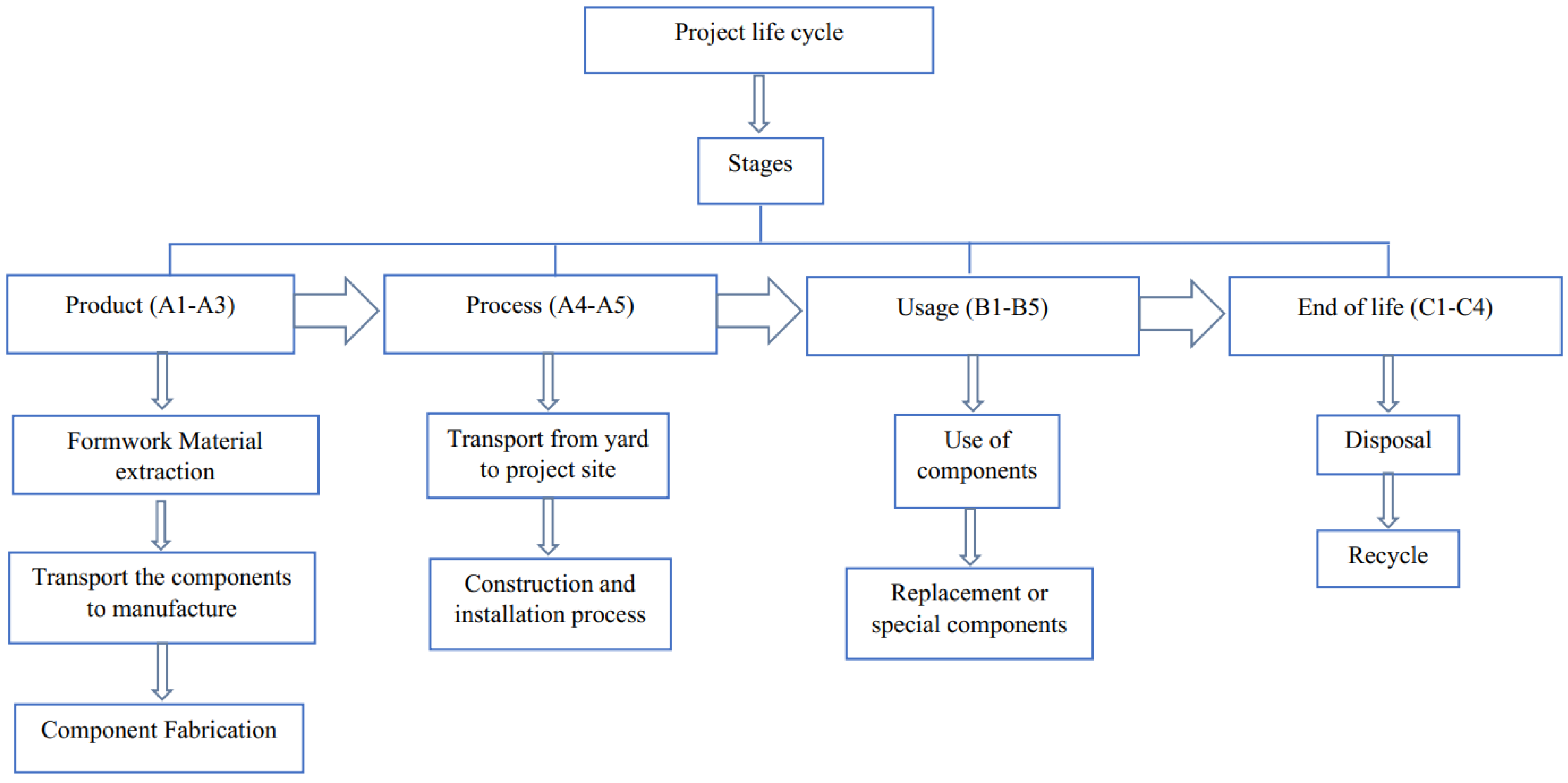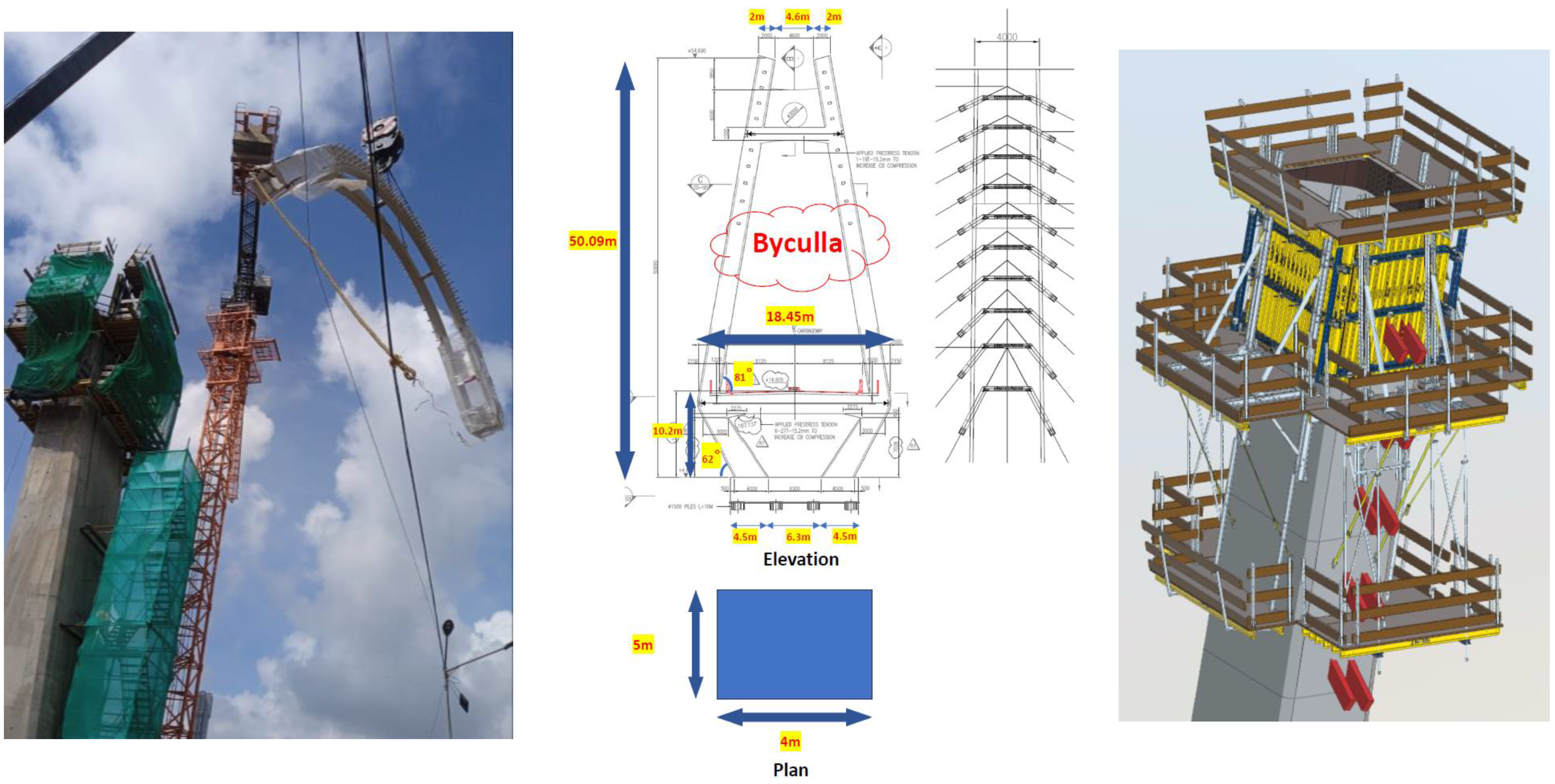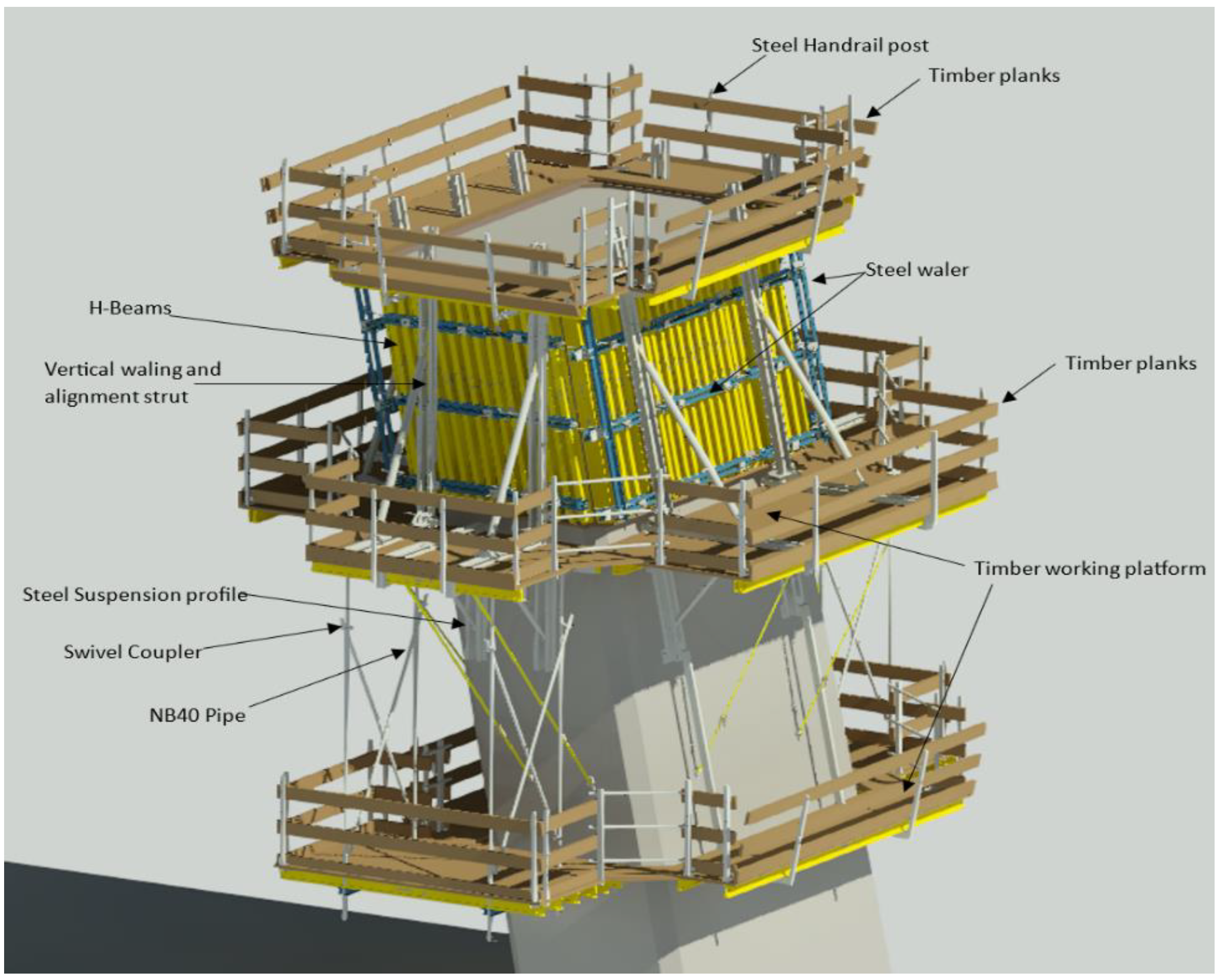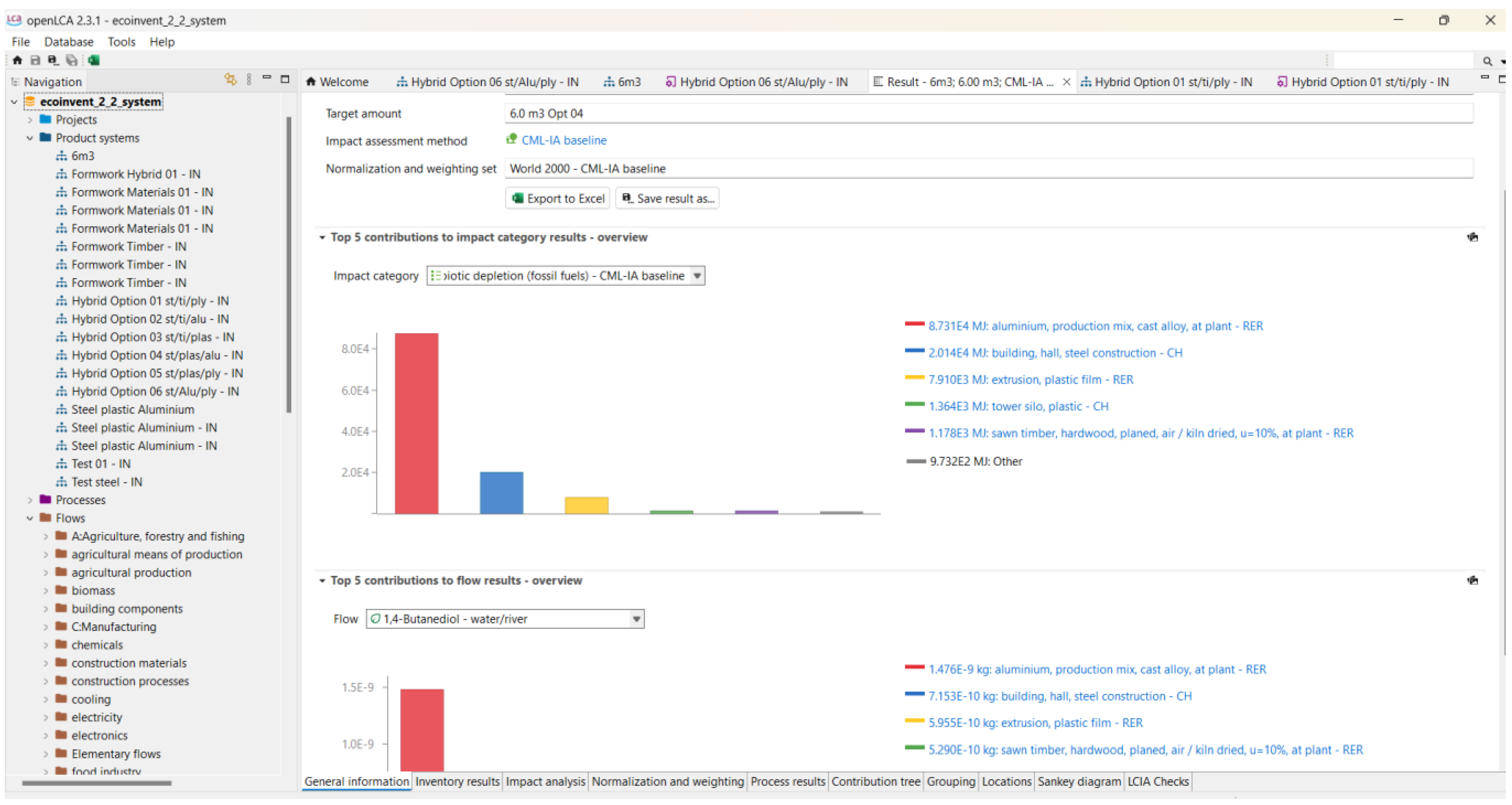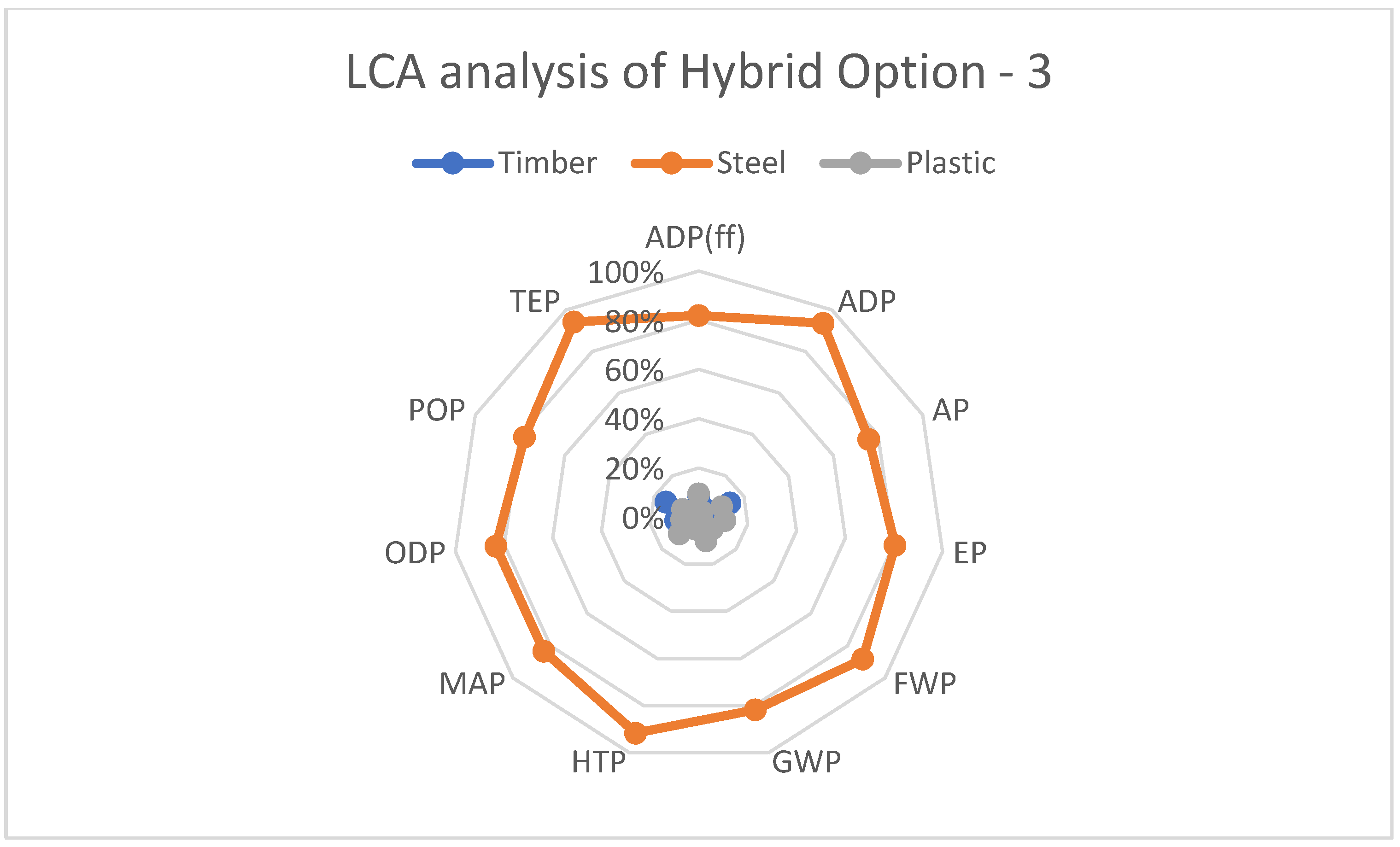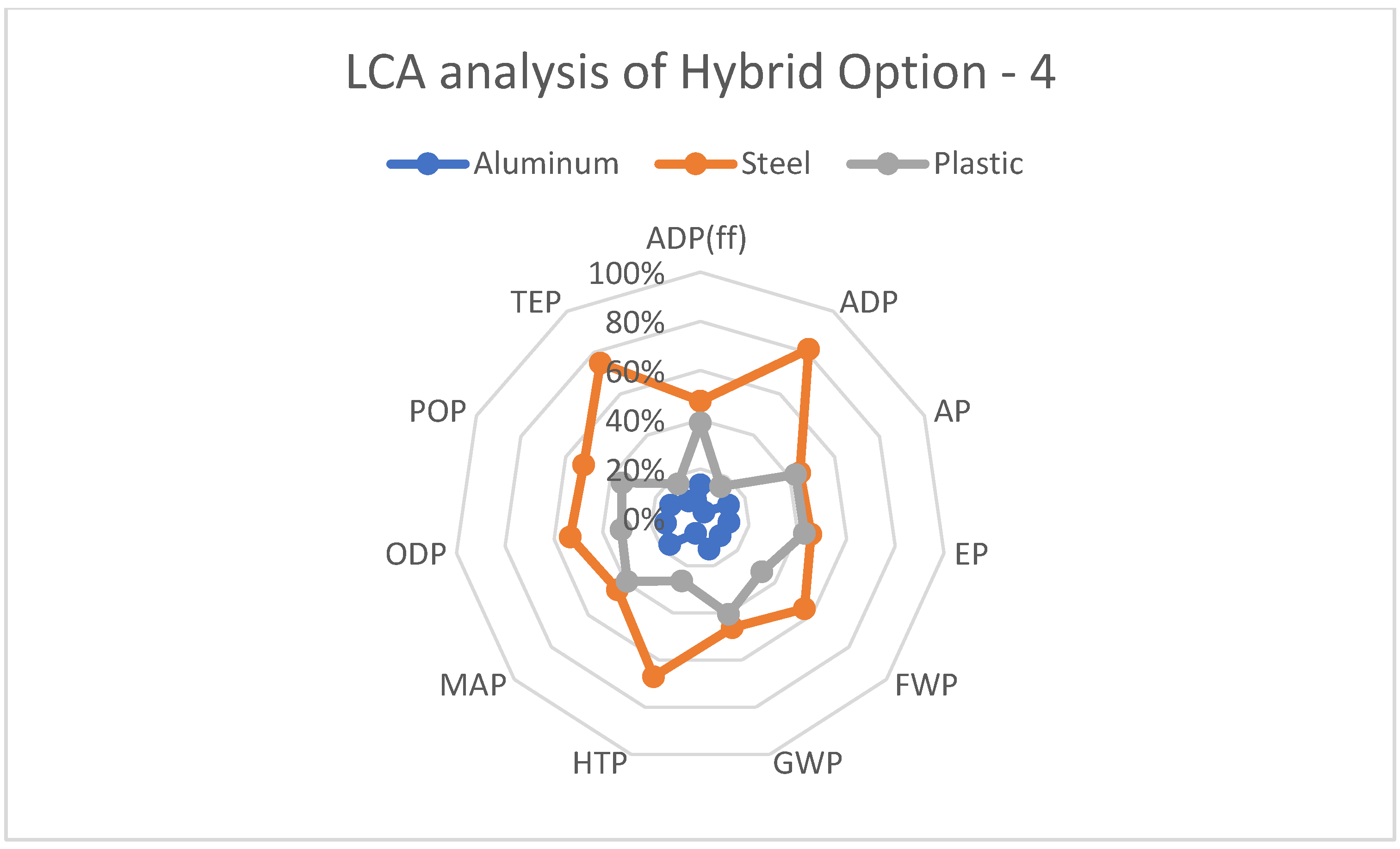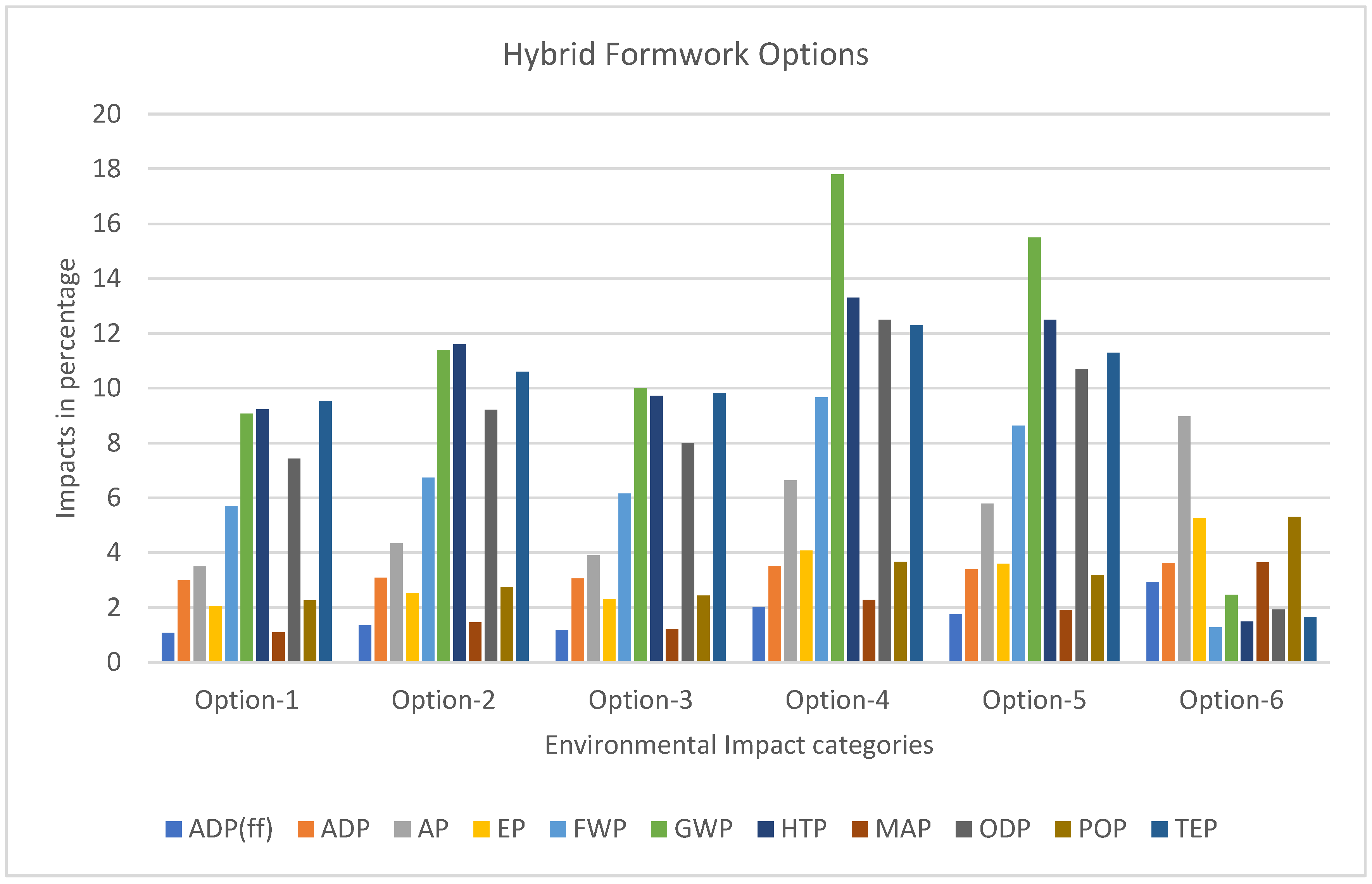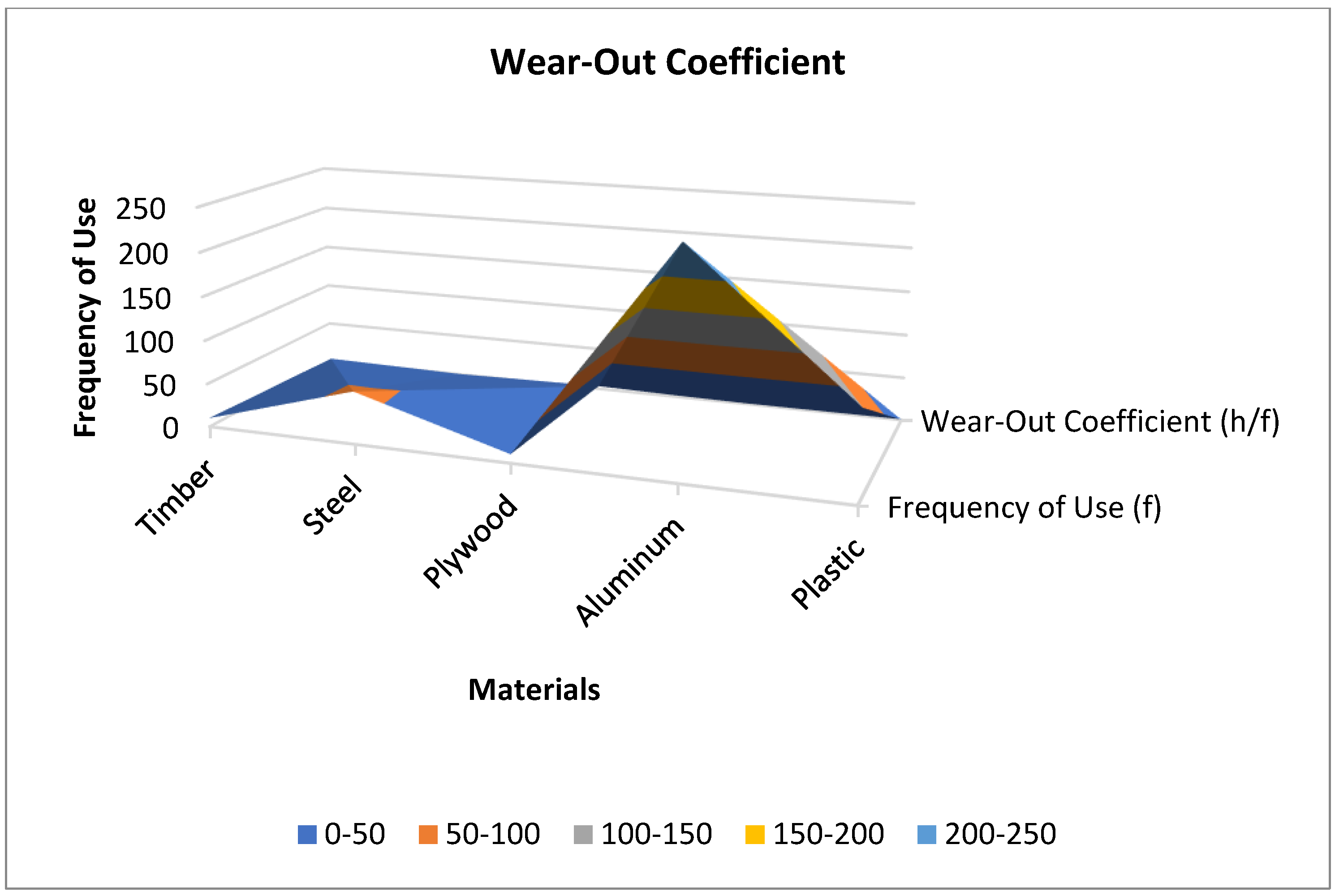1. Introduction
A formwork system is a cohesive assembly of components designed to support, shape, and contain concrete throughout the placing and curing phases until it achieves adequate strength to bear its weight. It employs form panels, supports, bracing, tie systems, and additional structural components to create a mold for the concrete [
1]. This essential system enables the molding of fresh concrete into its desired geometry and allows the concrete to rest and develop its strength, thereby reinforcing the structure. The removal of formwork occurs as soon as the concrete attains adequate strength in its hardened state, achieving at least twice the expected stress at the moment of removal.
Formwork constitutes the predominant expenditure in reinforced concrete (RC) construction, possibly comprising up to 60% of the unit cost of the RC structure and accounting for as much as 15% of the total construction costs [
2,
3]. Since the early Roman period, timber shuttering has been employed primarily as formwork for constructing concrete arches and vaults over the years [
4,
5]. Moreover, advancements in building technology have led to the development and use of several formwork types by the construction industry, as determined by their material and the specific construction requirements. It is regarded as a fundamental component of the construction of concrete structures.
Wei Li et al. [
6] classified formwork systems into three categories: traditional, flexible, and recyclable, based on the rigidity, the recyclability, and the technical fabrication of the material used. Wooden and metal formworks fall under the traditional formwork system, characterized by rigidity, and are extensively utilized across India’s construction industry.
1.1. Design and Selection Requirements of Formwork
Formwork is a temporary supporting framework utilized for the construction of reinforced concrete structures with specified geometric configurations and load-bearing capacities. The fresh concrete flows without any constraint and forms into a determined shape until it reaches adequate strength. Furthermore, the quality of formwork must exhibit exceptional durability, strength, and rigidity [
2,
7]. Nonetheless, the assurance of safety during the construction process is an essential characteristic that formwork must possess. A suitable material formwork and scaffolding system with sufficient strength can be utilized to support the loads and pressures [
8,
9]. When taking them into account, timber and metal formwork systems (traditional formworks) [
10] excel at withstanding the weights and pressures associated with the pumping of specialized fresh concrete [
11,
12], despite their inherent rigidity. Additionally, they exhibit quality in the final geometry and surface finishing at completion. These traditional formwork systems are fabricated by artisans proficient in manual construction techniques.
During the selection phase of the formwork system, considerations include the costs of formwork materials, labor for fabrication, assembly, and disassembly, as well as removal agents. Given these expenses, the overall cost of on-site concrete constructions indicates that the formwork system constitutes 50% to 60% of the total expenditure [
13,
14]. Given the susceptibility of formworks to weather conditions, the supplementary maintenance expenses should be taken into consideration. Under such conditions, corrosion may occur, diminishing the service life of metal formworks in wet locations. This results in insufficient concrete surface finishes. Under such circumstances, wooden-type formwork systems exhibit adaptability. The adaptability of formworks relies on configuring concrete components in diverse geometries and positions [
6,
15].
1.2. Wooden Formwork System
Timber formwork is the predominant formwork system extensively utilized across various engineering practices in construction in India, also referred to as the wooden formwork system. It is predominantly favored for its simplicity in cutting and assembling to attain the desired shape and proportions with standardized sizes and various combinations of wooden components. The chosen timber must be lightweight, seasoned, and devoid of termites [
6]. Members of larger sizes are classified as timber, whereas those of smaller sizes are classified as lumber [
7]. Engineered timber denotes prefabricated wood joists utilized for their enhanced load-bearing capability and reusability.
Plywood is a widely recognized material utilized in the building of wooden formwork systems, primarily serving as thin surface sheets. Plywood is a panel product created from cross-laminated thin sheets of wood veneer, which are adhered under heat and pressure using robust adhesives [
16]. These panels exhibit outstanding stability, impact resistance, and strength-to-weight ratio, along with excellent resistance to temperatures, humidity variations, and chemicals. The primary benefits include smoother surfaces and enhanced handling, allowing for reuse exceeding 50 times by reversing for dual-sided application [
17,
18]. The extensive availability of standardized lengths and thicknesses is a significant element. Additionally, certain research was conducted to obtain superior-performance plywood to improve the quality for modern constructions [
19].
Due to its numerous advantages, wooden formwork is often utilized in the construction sector; yet, certain difficulties arise when evaluating the life cycle assessment. The necessity for substantial labor in cutting and managing components, together with the time inefficiency, restricts the reuse of concrete structures with analogous geometries and results in a shorter lifespan compared to metal formworks due to their diminished capacity to maintain shape under strong loads. At this stage, they become inefficient, necessitating an additional scaffolding structure that is unsustainable relative to its initial condition [
20].
1.3. Metal Formwork System
Steel and aluminum are metal formwork systems, along with other frequently utilized formworks in India. Steel formwork techniques are particularly employed for curved or orthogonal-shaped constructions and concrete retaining walls. In comparison to wooden formwork systems, steel formwork offers superior stiffness and strength, facilitating quick erection, disassembly, and re-erection. The repeated utilization of steel formwork systems in a shorter timeframe reduces both time overruns and construction costs. The surface finish and smoothness of the cast concrete components are satisfactory [
6,
7].
The production and initial cost of steel formwork are elevated, rendering it uneconomical until utilized frequently, and it necessitates additional equipment or support for transportation due to its substantial self-weight. In low temperatures, the setting and hardening phase of concrete is prolonged. The durability of steel may be compromised by rust during the wet season. Moreover, this diminishes the surface quality of the concrete component, impacting its strength and longevity. The following are factors that should be regarded as downsides of steel formwork systems.
Aluminum formwork is a low-density formwork that is significantly lighter than steel. These typically develop into modular formwork systems using standardized components. Aluminum modular formworks facilitate the achievement of high-quality concrete surfaces and enhance the cost-effectiveness of construction projects [
21]. The building process is highly efficient, exhibiting little change in dimensions during the installation and removal of formwork components. Aluminum provides reduced handling costs, an extended service life, and the capability to manufacture significantly larger units compared to alternative materials [
22]. The bespoke manufacturing and use of steel and aluminum formworks pose challenges for intricate concrete structures. Insufficient compaction of concrete within metal formworks during filling results in a loss of cohesion and the formation of honeycombs. Furthermore, their production and upkeep expenses are comparatively elevated in relation to hardwood formwork systems. Nevertheless, reusability and repeatability generally lead to a reduction in the overall cost of a project.
Formwork systems are often classified into horizontal and vertical types. Horizontal formwork systems are employed for casting concrete in slabs and roofs, while vertical formwork systems are utilized for constructing columns and walls [
23]. Selecting the appropriate formwork system for a project poses a challenge for project and site managers, as it depends on numerous quantitative and qualitative aspects [
24]. The available types of formwork systems are wall/column formwork, climbing formwork, flex system, load-bearing system, scaffolding system, heavy-duty tower system, foundation system, and aluminum monolithic system [
25].
1.4. Hybrid Formwork System
Hybrid formwork systems enhance construction efficiency by integrating various materials according to the structural specifications and economic viability. Combinations of steel and plastic provide smooth, non-adhesive surfaces suitable for tunnel formwork, whereas aluminum and plastic are employed in maritime constructions [
24]. These combinations are determined by criteria such as the load-bearing capability, reusability, and finish requirements, assuring optimal performance.
3. Life Cycle Assessment (LCA)
Life cycle assessment (LCA) functions as a methodology to evaluate the environmental implications associated with construction materials throughout their complete life cycle. It evaluates the environmental impacts across many stages, including raw material extraction, production, transportation, building, usage, and disposal, as seen in
Figure 1 [
31]. LCA provides a systematic approach to assess the environmental performance of materials and identify opportunities for enhancement as the building sector shifts toward sustainable practices. The standards and publications from the International Organization for Standardization (ISO) 14000 series offer an established framework for LCA. According to ISO 14044 [
32], LCA entails the compilation of a product system’s inputs, outputs, and possible environmental impacts throughout its life cycle.
Structures account for over 40% of global energy consumption, 60% of electricity usage, and 30% of greenhouse gas emissions. Furthermore, buildings consume 40% of the available raw materials and generate nearly 35% of the global industrial waste [
33]. The selection of sustainable materials is imperative, as the formwork system constitutes around 60% of the total building cost. The carbon footprint (CF) measures the total amount of carbon dioxide (CO
2) emissions generated over a material’s entire life cycle, both directly and indirectly [
34]. The carbon footprint of formwork materials affects the project’s total emissions, and the selection of materials determines the embodied carbon, energy usage, and trash production. It is the primary determinant of the global warming potential (GWP).
BIM and LCA Integration
This research developed a cohesive digital workflow that integrates building information modeling (BIM) with life cycle assessment (LCA) to assess environmental consequences efficiently. The material requirements, encompassing the weights and physical qualities, were immediately sourced from Autodesk Revit, which provides dependable evaluations via its integrated material database.
The materials’ details were subsequently exported using customized schedules in widely recognized formats, including CSV and Excel. The exported data were precisely mapped and imported into OpenLCA software, enabling a smooth transition between the BIM environment and the LCA platform.
By integrating Revit and OpenLCA, the methodology facilitated comprehensive monitoring of the material impacts throughout several life cycle phases, including production, transportation, construction, operational use, and end-of-life processing. This methodology enhanced the data integrity, minimized the manual effort, and facilitated prompt updates in response to design modifications.
Furthermore, this integration of BIM and LCA facilitated ecologically responsible decision-making, conforming to sustainable development principles and certification criteria in green construction practices.
6. Scope of Study
Although many statistical models, like SPSS analysis with the parameters of EFA and AHP [
39], and MCDM [
40] models were utilized in many studies to determine the formworks’ efficiency and optimization of the material type in different case studies in the construction sector. In the case of LCA analysis, the majorly assessed the costs of fabrication, material delivery, stability, reusability, service life and other liable costs of different types of formworks [
41,
42,
43,
44,
45]. BIM-integrated LCA for analyzing the CO
2 emissions due to the wastage of timber formwork during fabrication and the end-of-life span is one of the advanced studies that has been implemented earlier [
46].
The necessity for this study derives from the scarcity of research concerning the construction of 3D BIM models for formwork systems, a topic that continues to be explored. Nonetheless, research pertaining to the integration of low-carbon materials, material reusability, and sustainable practices in buildings is markedly limited. The absence of standardized methodologies for LCA poses difficulties in accurately evaluating environmental impacts. This paper seeks to assess and determine the most effective hybrid formwork system using life cycle assessment (LCA) and examine the materials’ wear-out coefficient (WOC) through a case study.
7. Study Methodology and Data Collection
This research was carried out at the cable-stayed bridge pylon location in Byculla, Mumbai (
Figure 3). The supplies (materials) were obtained from a construction yard located 60 km distant in Taloja. The project entails the design and construction of a cable-stayed bridge, characterized by a pylon-supported structure with a height of 50.37 m, consisting of 16 castings of 3.5 m each for one leg and 32 castings for two legs. The data obtained from the site were utilized to create a 3D model of a cable-stayed pylon for assessing the formwork area (
Figure 4).
The primary structural elements were casting 01 (lower pylon) and casting 06 (upper pylon), illustrated in
Figure 5 and
Figure 6, respectively.
Figure 7 illustrates that the components and their respective materials are enumerated in
Table 1 and
Table 2. The chosen formwork elements consisted of wall panel systems and climbing formwork systems, incorporating materials such as plywood, lumber, engineered timber, and steel. Utilizing the data gathered from the site, a 3D model has been created for the formwork system, encompassing components such as plywood sheets, H-beams, compression struts, steel walers, alignment struts, tie rods, super plates, connecting plates, pins, lifting brackets, nails, and additional accessories.
Data from the 3D model were extracted via Autodesk Revit 2019 software for the life cycle assessment study [
47]. The life cycle assessment (LCA) was conducted via OpenLCA software, with the ecoinvent database serving as the standard reference, following ISO 14044 for the analysis. The functional unit for this investigation was 1 m
3 of surface components and 1.0 kg of supporting structural components, covering each concrete pour cycle [
41]. The LCA encompassed the complete life cycle of the material, from extraction to final disposal. In recent years, building materials, components, and entire structures have been the focus of nearly double the number of life cycle assessment-related studies [
48,
49].
Wood constitutes the primary material in traditional formwork systems, providing economic advantages relative to alternative methods. Nevertheless, it has restricted reusability and is prone to swelling, distortion, and fracturing. The 3D model of the conventional formwork system was created by integrating timber elements of diverse sizes. A 50 mm thick timber served as the working platform, while 200 × 50 mm timber was utilized for the handrail posts. The total timber volume was estimated to be 11.43 m3 based on the 3D model. This study utilized approximately 1313 m3 of concrete for the construction of the cable-stayed pylon, encompassing 32 successive castings. The initial casting’s volume was 60 m3, with the sizes progressively diminishing in later pieces. This concrete volume directly affected the planning of the formwork reuse cycles and structural scheduling.
8. Case Study for Current Research
This case study utilizes hybrid materials comprising steel, timber, and plywood. The components of the system are enumerated below.
Figure 7 illustrates the quantity and density of the timber and plywood components utilized in the formwork elements and sectional view. The plywood, lumber, and engineered timber components in the formwork area are enumerated in
Table 1.
Table 2 presents the steel components utilized in the formwork system.
This study contrasts traditional materials such as timber and wood with alternatives, including low-carbon steel, aluminum, plastic, and recycled boards. Multiple hybrid formwork alternatives are created by substituting the current material in the case study with aluminum, steel, plywood, plastic, and lumber, as seen in
Table 3. In our study, the steel components remain unchanged across all the hybrid formwork alternatives, while the lumber and plywood components are substituted with aluminum and plastic.
The data utilized for the analysis of the hybrid formwork systems are sourced from the ecoinvent database in accordance with the ISO 14044 standards, and the employed data are presented in
Table 4. The carbon footprint of the item is ascertained using the CO
2 emissions factor, which is 10.15 kg CO
2 per gallon for diesel fuel.
LCA Analysis
The LCA analysis is conducted for the conventional and hybrid formwork systems, including a case study and alternative solutions. The quantities of steel are measured in kilograms, and the lumber in cubic meters. The quantities utilized in the case study serve as the benchmark for our research, and the variations in the quantities for the alternative hybrid choices are contingent upon the alterations in the material density employed. For instance, consider substituting lumber materials measured in cubic meters with an alternative material such as plastic. The volume of timber material is multiplied by the density of plastic to determine the total quantity of plastic utilized for the investigation. The total quantities of materials for the different alternatives are presented in
Table 5.
The LCA analysis focuses on key metrics such as the abiotic depletion potential (fossil fuels) (ADP (ff)), abiotic depletion potential (ADP), acidification potential (AP), eutrophication potential (EP), freshwater aquatic ecotoxicity potential (FWP), global warming potential (GWP), human toxicity potential (HTP), marine aquatic ecotoxicity potential (MAP), ozone layer depletion potential (ODP), photochemical oxidation potential (POP), and terrestrial ecotoxicity potential (TEP). The research results underscore the significance of material selection in mitigating environmental impacts and demonstrate how LCA may improve sustainable construction methods.
The wear-out coefficient is a numerical statistic that measures the rate of material degradation over time. This calculation is based on the frequency of materials utilized in construction, which affects the environmental impact of the formwork system and serves as an indicator of the materials’ overall service life. It signifies the resilience of materials; a lower number denotes enhanced durability, indicating an extended lifespan for the substance. The wear-out coefficient for the materials utilized in the 32 castings in the design is presented in
Table 6 below.
The formwork system typically accounts for approximately 40% to 60% of the overall construction expenditure [
50]. The expense of materials utilized in the formwork system also affects the choice of an appropriate system that is both sustainable and economically viable. The material rates are derived from the schedule of rates (SOR) pertinent to the case study region, Mumbai, and the aluminum rate is established according to the prevailing practices of the MIVAN formwork application [
51]. The price of 12 mm thick plywood is sourced from the standard operating rate (SOR) for the requisite conversions for 1 m
3 of material [
51]. The plastic cost is determined by the prevailing market rate. The different rates of the materials are presented in
Table 7 below.
The wear-out coefficient of the materials affects the overall project cost, as the frequency of repetitions varies for each material. Aluminum exhibits the highest durability with 300 cycles, followed by plastic at 120 cycles, steel ranging from 80 to 100 cycles, plywood at approximately 50 cycles, and hardwood, the least durable material, with roughly 10 cycles [
1,
52]. This study considers a total of 50 cycles for utilization, and the cost estimate for these 50 cycles has been conducted.
9. Results and Discussion
The output results of OpenLCA and the environmental impact assessment of the hybrid formwork components for the pylon bridge case study, and their cost analysis of these hybrid combinations, are discussed below. The contribution of the carbon emissions scale output of a hybrid formwork is shown in
Figure 8.
The environmental impact assessment of conventional timber formwork systems through LCA reveals significant environmental concerns. The findings are listed below in
Table 8.
The findings reveal the environmental drawbacks of the timber formwork system, since it impacts marine and freshwater ecosystems, affects human health, and involves energy-intensive production. The current study emphasizes the necessity of sustainable alternatives to the current formwork system.
9.1. Hybrid Formwork System of Option 1
The impact assessment of the hybrid formwork system, including the case study, reveals the environmental impacts of these systems. For our case study, the materials used for the analysis are steel, timber, and plywood. The environmental impact of these materials is presented in
Table 9 below.
Table 9 reveals that steel is the major contributor to most environmental impacts, followed by timber, which has moderate impacts, and plywood, which has the least impact. The same analysis is carried out for the remaining hybrid options, and their environmental impacts are assessed and tabulated below.
9.2. Hybrid Formwork System of Option 2
The impact assessment of the hybrid formwork system, incorporating timber, aluminum, and steel, reveals the environmental impacts of this system, as stated in
Table 10 below.
Table 10 and
Figure 9 reveal that steel is the major contributor to most of the environmental impacts, followed by aluminum, which has a moderate impact, and timber, which has the least impact when compared to the other two.
9.3. Hybrid Formwork System of Option 3
The impact assessment of the hybrid formwork system, incorporating timber, plastic, and steel, reveals the environmental impacts of this system, as listed in
Table 11 below.
Table 11 and
Figure 10 reveal that steel is the major contributor to most of the environmental impacts. Plastic has a moderate impact in general, but the least impact on some metrics, like the ODP and AP, and timber has the highest impact on these metrics. However, timber generally has the lowest impact of the three materials.
9.4. Hybrid Formwork System of Option 4
The impact assessment of the hybrid formwork system, incorporating steel, aluminum, and plastic, reveals the environmental impacts of this system, as stated in the
Table 12 below
Table 12 and
Figure 11 reveal that steel is the major contributor to most of the environmental impacts, followed by plastics, which have a moderate impact, and aluminum, which has the least impact.
9.5. Hybrid Formwork System of Option 5
The impact assessment of the hybrid formwork system, incorporating timber, aluminum, and steel, reveals the environmental impacts of this system, as stated in
Table 13 below.
Table 13 and
Figure 12 reveal that steel is the major contributor to most of the environmental impacts, followed by plastics, which have a moderate impact, and plywood, which has an almost negligible impact.
9.6. Hybrid Formwork System of Option 6
The impact assessment of the hybrid formwork system, incorporating timber, aluminum, and steel, reveals the environmental impacts of this system, as stated in
Table 14 below.
Table 14 and
Figure 13 reveal that aluminum is the major contributor to most of the environmental impacts, followed by steel, which has a moderate impact, and plywood, which has an almost negligible impact.
9.7. Environmental Impact Assessment
The life cycle assessment (LCA) of the formwork system identifies potential environmental hazards associated with the materials utilized. The examination of the traditional formwork system identifies numerous environmental disadvantages, such as ecosystem damage and resource depletion, and emphasizes the necessity of a transition to more sustainable techniques. The hybrid formwork systems were selected for analysis, incorporating various material combinations. Every material combination utilized in the hybrid formwork system has distinct environmental implications related to the metrics evaluated in this study. The environmental implications of each hybrid formwork system alternative are analyzed in relation to
Figure 14 and
Table 3.
The ADP (ff) metric was the lowest at 10% in the steel, timber, and plywood system, while it reached the maximum level of 28% in the aluminum, steel, and plywood system. The ADP metric was lowest at 15% in the steel, timber, and plywood system, and highest at 18% in both the steel, plastic, and aluminum system and the steel, aluminum, and plywood system. The global warming potential (GWP) was minimal at 10% in the steel, timber, and plywood systems, while it peaked at 28% in the aluminum, steel, and plywood systems. The AP metric was lowest at 11% in the steel, timber, and plywood system and highest at 27% in the aluminum, steel, and plywood system. The EP measure reached its peak at 27% in the aluminum, steel, and plywood system, while it was at its nadir at 10% in the steel, timber, and plywood system.
The FWP measure was lowest at 11% in the steel, timber, and plywood system, and highest at 26% in the aluminum, steel, and plywood system. The HTP was lowest at 13% for steel, timber, and plywood, and highest at 21% for aluminum, steel, and plywood. The MAP was lowest (9%) in the steel, timber, and plywood system and highest (31%) in the aluminum, steel, and plywood system.
The ODP was minimal (11%) in the steel, timber, and plywood system and maximal (29%) in the aluminum, steel, and plywood system. The POP was lowest (12%) in both the steel, timber, and plywood system and the steel, timber, and plastic system, while it was greatest (27%) in the aluminum, steel, and plastic system. The TEP was highest at 24% in the aluminum, steel, and plywood system, and lowest at 14% in both the steel, timber, and plywood system and the steel, timber, and plastic system.
9.8. Wear-Out Coefficient
The evaluation of the material wear coefficients and embodied carbon for 32 castings underscores the considerable disparity in the environmental sustainability of the various formwork systems. The industrial timber formwork system has the most significant environmental impact, while the traditional timber formwork system ranks second, exhibiting an impact 30 times greater than that of the conventional timber formwork. This is mainly because of the elevated wear-out coefficient of timber and plywood (3.20), which requires frequent replacements, hence escalating the resource consumption and waste production.
In contrast, the combined formwork systems exhibit minimal environmental impact, mostly due to including materials with reduced wear-out coefficients, like aluminum (0.13) and plastic (0.32). The extended lifespan of aluminum markedly diminishes the material depletion and waste production, rendering it an ideal selection for sustainable building. Steel, possessing a wear-out coefficient of 0.53, offers superior durability compared to timber and plywood, although it is less sustainable than aluminum. Plastic presents a feasible option, reconciling durability with environmental consequences. Mitigating material degradation is essential for lessening environmental impacts in formwork systems. Hybrid methodologies that integrate resilient elements such as aluminum and steel, while minimizing the use of high-wear substances like timber and plywood, can enhance longevity and diminish the overall environmental effects. Future studies should investigate optimized material combinations that improve the formwork durability, cost-efficiency, and sustainability in construction methods.
The calculated WOC values for the chosen materials are presented in
Table 6. A reduced WOC signifies an increased potential for reuse and, hence, enhanced sustainability. For instance, aluminum has the lowest WOC (0.13), indicative of its extended service life and elevated reuse frequency (250 uses). Conversely, timber and plywood exhibit the greatest WOC values (3.20), indicating restricted reuse potential.
The results are subsequently illustrated using a bar chart in
Figure 15 to emphasize the comparative performance of each material regarding the wear-out behavior, facilitating the material selection process for sustainable formwork systems.
10. Cost Analysis
A cost analysis has been conducted for the materials utilized in the formwork construction process. The aggregate amount of materials utilized for several hybrid formwork alternatives is detailed in
Table 5, while the material unit cost is specified in
Table 7. This study is conducted using Hybrid Option 1 as the baseline, with the alternatives adjusted accordingly, as outlined in
Table 5. Steel is the predominant material in all the alternatives, whereas timber and plywood in Hybrid Option 1 are exchanged with aluminum and plastic, or with each other. The overall expense of the hybrid formwork system for a single cycle is detailed below.
Table 15 provides an analysis of the material costs utilized in the case study, indicating that lumber is the primary cost contributor to building in one option, although it is the least contributor in another context. The whole expenditure amounts to approximately USD 12,927, with lumber accounting for roughly USD 9131, steel for USD 3147, and plywood for approximately USD 650.
Table 16 presents an overview of the costs associated with items employed in Hybrid Option 2. This case study involves the replacement of the plywood components with aluminum, which constitutes the principal cost factor, succeeded by lumber. The whole expenditure amounts to USD 26,087, with aluminum accounting for around USD 13,811, lumber for USD 9131, and steel for USD 3147.
Table 17 provides insights into the cost analysis of the components utilized in Hybrid Option 3. The aluminum components in Hybrid Option 2 are substituted with plastic, which is somewhat less expensive than aluminum; however, timber remains the primary cost contributor. The total expenditure amounts to USD 18,710, with timber and plastic contributing approximately USD 9131 and USD 6434, respectively, and steel accounting for about USD 3147.
Table 18 provides insights into the cost analysis of the components utilized in Hybrid Option 4. The timber and plywood components in the case study are substituted with plastic and aluminum, respectively. It indicates that the cost of plastic exceeds three times that of metal. The whole expenditure amounts to USD 62,681, with plastic accounting for USD 45,725, aluminum for USD 13,811, and steel for approximately USD 3147.
Table 19 provides insights into the cost analysis of the components utilized in Hybrid Option 5. The timber components in the case study are substituted with plastic, while the plywood components remain unchanged. Plastic constitutes the predominant cost factor in this system. The whole expenditure amounts to USD 49,521, with plastic accounting for approximately USD 45,725, steel for USD 3146.40, and plywood for roughly USD 650.
Table 20 provides insights into the cost analysis of the components utilized in Hybrid Option 6. The timber components in the case study are substituted with aluminum, but the plywood components remain unchanged. In this instance, aluminum is the predominant cost contributor among all the accessible elements in the alternative hybrid solutions. The whole expenditure amounts to approximately USD 101,949, with aluminum accounting for about USD 98,153, steel for USD 3145, and plywood for USD 650.
The expenses associated with a single cycle of material usage for the current hybrid alternatives are detailed above in
Table 15,
Table 16,
Table 17,
Table 18,
Table 19 and
Table 20. The total cost of the materials utilized in the case study (Hybrid Option 1) is the least expensive at USD 12,927, followed by Hybrid Option 3, which totals approximately USD 18,710. This study considers a total of 50 cycles for repetitions. The cost study has been completed and is presented below in
Figure 16.
This study demonstrates that utilizing lumber in formwork systems for extensive repetitive use is costly, but employing materials such as steel, aluminum, and plastic is more economical. Nevertheless, there are specific constraints associated with the use of steel, aluminum, and plastic. These constraints must be acknowledged to enhance the sustainability of construction techniques. The potential limitations associated with these materials include the elevated carbon emissions during the fabrication of steel, the unsuitability of aluminum for subsequent alterations in the mold, and the environmental degradability of plastic during extended usage. According to this study, Hybrid Option 5, which utilizes materials such as steel, plastic, and plywood, is the most economical, with a total cost of USD 49,521, equivalent to the cost of a single use of this material combination. This is followed by Hybrid Option 4, also incorporating steel, plastic, and plywood, with a total cost of USD 62,681. The Hybrid Option 1, which utilizes components such as steel, timber, and plywood, is the most economical choice in the entire assessment, totaling USD 49,447. Nevertheless, while evaluating the singular cycle utilization of materials alongside their recurrent application, Hybrid Option 5 emerges as the most economical choice, as the repeated use of lumber may lead to heightened environmental repercussions linked to excessive timber consumption.
Hybrid methodologies that integrate resilient elements like aluminum and steel, while minimizing the use of high-wear substances like timber and plywood, can enhance the longevity and diminish the total ecological footprint. Future studies should investigate optimized material combinations that improve the formwork durability, cost-efficiency, and sustainability in construction methodologies.
11. Conclusions
This study evaluated the environmental implications by comparing the traditional formwork system with six alternative hybrid formwork systems that utilize materials such as steel, aluminum, plastic, and plywood, employing life cycle assessment (LCA) and accounting for the material wear-out coefficient. The findings indicate that traditional formwork systems impose significant environmental loads, whereas hybrid formwork systems allocate the environmental impact across materials, providing a balanced and sustainable solution. The principal conclusions of this study are as follows:
The conventional formwork system exhibits increased environmental burdens, reflecting the risks to aquatic and freshwater ecosystems, reduced fossil fuel levels, and increased energy consumption for timber processing.
Steel-dominant systems (Hybrid Options 1, 2, and 3) generally exhibit the highest impact across many categories, as steel increases carbon emissions and fossil fuel depletion, making it a less sustainable option.
Aluminum-incorporated systems (Hybrid Options 2,4 and 6) reduce toxicity and reflect a shift in environmental impact.
Plastic-incorporated systems (Hybrid Options 3,4, and 5) balance the distribution of environmental impacts among materials, reducing steel’s dominance but introducing concern in terms of acidification metrics.
Plywood offers the least impact among the materials and offers the most sustainable solution.
The analysis of the wear-out coefficient of the materials highlights that timber and plywood have the shortest lifespans, leading to high environmental impacts.
Aluminum has the longest lifespan among the materials, with a wear coefficient of 0.13, making it the most sustainable option.
Timber is the costliest material with a lower repetition cycle, while aluminum offers a higher repetition cycle of 250.
The hybrid options incorporating materials like steel, plastic, and plywood (Hybrid Option 5) and options incorporating materials like steel, aluminum, plastic (Hybrid Option 4) have a minimal total cost for a longer life cycle.
The best sustainable solutions suggested by this study are Hybrid Option 2 and Hybrid Option 4. Hybrid Option 2 incorporates materials like steel, timber, and aluminum. This system is a sustainable option because of the reusable nature of the materials used (steel and aluminum) and the lower environmental impact of timber. Hybrid Option 4 incorporates materials like steel, plastic, and aluminum. This system is sustainable as it combines materials with lower wear-out coefficients, indicating a reduced environmental impact.
This study emphasizes the necessity of material selection optimization to improve formwork sustainability, prolong the materials’ service life, and reduce the environmental effects. In future studies, different types of optimal material combinations must be studied to achieve structural efficiency and environmental sustainability in formwork design. The combined formwork system, incorporating durable materials with the lowest environmental impact, reduces material depletion and waste generation.
